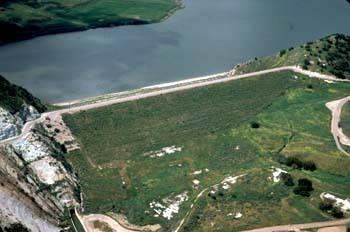- elevation 3,807 ft (1,160 m) Basin area 2,932 km² | - elevation 354 ft (108 m) Length 190 km Country United States of America | |
 | ||
- left Santa Barbara Creek, Cottonwood Creek (Cuyama River), Mustang Creek, Pine Creek (Cuyama River) - right Quatal Creek, Huasna River - location near Garey, San Luis Obispo andSanta Barbara Counties | ||
California route 166 through the cuyama river canyon
The Cuyama River (/kwiːˈjɑːmə/ kwee-YAH-mə, /kuːˈjɑːmə/ koo-YAH-mə, or /kwiːˈjæmə/ kwee-YAM-ə) is a 118-mile-long (190 km) river in southern San Luis Obispo County, northern Santa Barbara County, and northern Ventura County, in the U.S. state of California. It joins the Sisquoc River forming the Santa Maria River. The river's name comes from an Indian village named for the Chumash word kuyam, meaning "clam" or "freshwater mollusk".
Contents
- California route 166 through the cuyama river canyon
- Map of Cuyama River California USA
- Course
- Management
- References
Map of Cuyama River, California, USA
Course
The Cuyama River's source is in San Emigdio Mountains, within the Chumash Wilderness area of the Los Padres National Forest at an altitude above 8,000 feet (2,400 m). The river's upper reaches are in Ventura County, where several tributaries join before the mainstem river exits Los Padres National Forest. After leaving the national forest the river enters Santa Barbara County and flows through the 45-mile-long (72 km) Cuyama Valley, which lies between the Caliente Range and the Sierra Madre Mountains. The river flows past the towns of Cuyama and New Cuyama. Through most of the Cuyama Valley and downriver to its confluence with the Sisquoc River the Cuyama River forms the approximate boundary between Santa Barbara County and San Luis Obispo County.
Downstream from the Cuyama Valley the river enters Twitchell Reservoir, after which it flows another 6 miles (9.7 km) to its confluence with the Sisquoc River. The joined streams are called the Santa Maria River, which flows about 20 miles (32 km) to the Pacific Ocean.
The river's course has evolved over its history by fault displacement.
Management
About 66 miles (106 km) from its source the river reaches Twitchell Reservoir, formed by Twitchell Dam. The dam provides flood control and allows water to be released gradually, so that as much of it as possible will seep into the soil and recharge the groundwater aquifer. The water is released as quickly as possible while still allowing it percolate into the ground, so the reservoir is often empty. The river and the reservoir are usually dry during the summer, when there is little or no rain. However, large flows can occur following winter storms.
